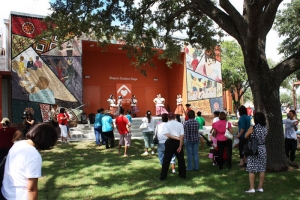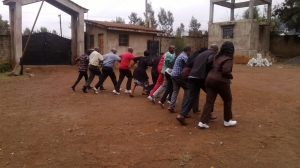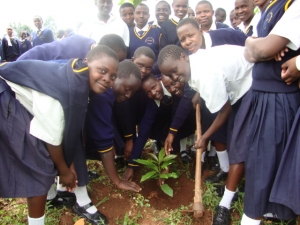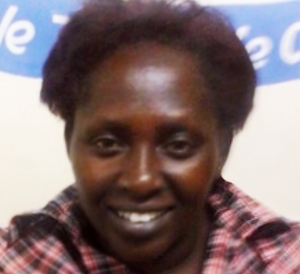One of the key aspects that drew me to Appreciative Inquiry (AI) and keeps me involved is the gratitude people express and the way they (including myself) feel imbued by such a thankful experience. This was especially evident in the stories people shared at the World Appreciative Inquiry Conference (WAIC) in Johannesburg, South Africa 2015. The true spirit of ubuntu, “I am because we are”, where human virtues such as compassion and humanity are central, was evident throughout the conference. Looking ahead to the upcoming WAIC in Nice, France in March 2019, it is clear by the societal ambition of the conference – “Generating conversations for the common good” – that gratitude throughout the entire AI experience remains pivotal to its message and focus on building positive communities.
Appreciative Inquiry: Gratitude at the heart of conversation
Stories of deep appreciation for the way AI has transformed organisations, and perhaps more precisely the way it has transformed individuals and teams within those organisations, are always told in the context of gratitude for what has been explored, discovered, learned, shared, and what continues. A person-centred and strengths-based approach such as AI values, encourages and celebrates all that people have to offer while ensuring they remain at the heart of the change process. I’ve often commented that transformational leadership understands and supports what motivates individuals as it creates the conditions that promote healthy relationships. Indeed, motivation is the manifestation of what is meaningful, which gives us the “why” for what we do. Good leaders understand this and the AI process promotes it.
AI and gratitude
My understanding of gratitude emanates from my earliest experience of the way my father went about his daily life and how he approached the world of work in the same way. He was a well-known and much loved carpenter and French polisher, and of all the things he shared with me throughout the many creative hours enjoyed together in his workshop, his most inspiring and enduring words continue to resonate with increasing meaning: “Do your best; give now; be in community”. The wisdom with which he embraced his talents, shared his skills and engaged with others emphasised the importance of relationship and how gratitude carries this in a way that enables us to experience and share our talents. All in all, I realised that we had choices, among them three powerful choices that would always open the way for gratitude to surface and do its work as we went about doing ours:
- Choose to be inspired so the best in you can be realised;
- Choose to dream so who you are and what you can give will be clear;
- Choose to be with others so that the future can be shared and strong.
It was no surprise to me that I was immediately attracted to all that the AI approach offers. This is especially so for the natural way it evokes the kind of experience where gratitude can flourish and enable us to see with a particular clarity only possible through gratitude. Indeed, my articulation of the three choices noted above was only possible through the gratitude I experienced, and I was all the more excited and grateful when I realised that AI does everything to help them along:
- In choosing to be inspired, AI asks inspirational questions;
- In choosing to dream, AI emphasises that what we focus on becomes our reality; and
- In choosing to be with others, AI highlights that in every community something works.
An inspirational model
It is easy to understand the level of gratitude expressed by people who have engaged in the AI process, given its design, intention and the way it encourages individuals and teams to move beyond being on the cusp of something great to experiencing the transformational power of positive discourse. It does this by tapping into the positive core and maintaining a clear and unwavering focus on what is already working well and building on this. The five core principles of AI, Constructionist, Poetic, Simultaneity, Anticipatory and Positive, are intrinsic to its underlying philosophy and generate conversations that inspire individuals and teams to recognise and contribute their best (Watkins, Mohr and Kelly, 2011). The overall model – the 5D cycle of Definition, Discovery, Dream, Design, Destiny/Delivery – provides the process that drives change within the organisation (Watkins, Mohr and Kelly, 2011).
Specific aspects of Appreciative Inquiry emphasise that:
- We can build on the best of the past;
- The positive core makes up the best of individuals and the organisation;
- We can co-create what we imagine;
- What we focus on becomes our reality.
Questions posed set the direction and ultimately provide a window into:
- The best within each person;
- When people feel most creative and productive;
- How leadership can encourage and build on what people value most;
- What motivates people.
As noted by Cooperrider, Whitney and Stavros (2008): “Appreciative Inquiry is the cooperative co-evolutionary search for the best in people, their organizations, and the world around them.”
Grateful Voices from the Field
Stories of gratitude for the AI approach are the seeds of inspiration; so much so that they foster the kind of curiosity where others feel compelled to find out more about the process and how it can be applied in their work.
Since the World Appreciative Inquiry Conference (WAIC) in 2015, AI practitioners from across the globe have been encouraged to contribute articles to the “Nourish to Flourish – Voices from the Field” section of the AI Practitioner journal as a way of sharing their experiences of the AI process. Twenty articles in total have been published in the past three years, and a selection of grateful sentiments from some of these articles are included below:
AI Practitioner: February 2016 | Volume 18, Number 1
Title: My AI Journey: From Learner Via Practitioner to Contributor
Author: Dr. Claudia Gross – Germany / Egypt.
During my AI Introduction training, I experienced the magic and power of the AI interview myself. Ever since, I have been eager to provide a similar experience for other persons. (p. 68.)
AI Practitioner: May 2016 | Volume 18, Number 2
Title: AI: Positive Change in Unexpected Places
Author: Whitney Fry – USA.
AI complemented my worldview as a follower of Jesus, and provided a practical application of gratitude: seeing positive change in unexpected places. AI, in many ways, was the reset button to my “hope meter”, and my vision suddenly opened from a myopic perspective of deficit details to the bigger picture of possibilities. (p. 74.)
AI Practitioner: May 2016 | Volume 18, Number 2
Title: AI and Strengths-based Social Work: Perfect Partners
Author: Petra van Leeuwen – The Netherlands.
Almost 20 years from the beginning of my work with the homeless women, it feels like I am still graduating … With my new implementation partner, AI, I hope to be involved in much more strengths-based social work. It is wonderful to see what happens in social work and care if we actually look at people as complete persons and build on their strengths. (p. 76.)
AI Practitioner: August 2016 | Volume 18, Number 3
Title: My Appreciation of Appreciative Inquiry
Author: Suzanne Quinney – UK.
AI is, indeed, that inner and outer journey that gently challenges us to appreciate the inherent power of that journey in taking us to where we need to be! (p. 74.)
AI Practitioner: November 2016 | Volume 18, Number 4
Title: Appreciative Approach: The Positive Gaze Upon Our Humanity
Author: Vânia Bueno Cury – Brazil.
AI is an enlightened lens through which to see and understand life. It is the way of compassion towards oneself and others, and a possible path for dreaming and gratitude. (p. 63.)
AI Practitioner: May 2017 | Volume 19, Number 2
Title: Towards Manifesting Imagination
Author: Roopa Nandi – India.
AI is not a tool – it is an approach that has the potential to drive individual behaviour and transform character. Through the appreciative lens every individual can affirm the self. (p. 104.)
AI Practitioner: August 2017 | Volume 19, Number 3
Title: Cultivating Appreciative Communities
Author: Nelly Nduta Ndirangu – Kenya.
Together with a team of professionals, we have borrowed extensively from the AI model to add value to the kind of education being delivered to children in Kenya. The approach has brought together parents, community and teachers to experience learning that is later cascaded to their children in the school setting. (p. 50.)
AI Practitioner: August 2018 | Volume 20, Number 3
Title: Creative Practices: Developing Leadership Confidence in Canadian Students
Authors: Rosemary Bell and Amanjot Gill – Canada.
…the use of Appreciative Dialogue with the placement students resulted in a much deeper and meaningful participation from them in workshops and their placement overall, which was reflected in their evaluation surveys. (p. 82.)
Gratitude breeds gratitude: when we experience it in ourselves, we wish for others to experience it as well. This is the greatest desire for humanity because gratitude serves as our ultimate guide to becoming better beings for the good of our global community and indeed, all life!
References
Cooperrider, D. L., D. Whitney and J. Stavros. (2008) Appreciative Inquiry Handbook: For Leaders of Change. San Francisco: Berrett-Koehler.
Watkins, J., B. J. Mohr and R. Kelly. (2011) Appreciative Inquiry: Change at the Speed of Imagination (Second Ed.), San Francisco: Pfeiffer.
Keith is a registered psychologist with the Psychology Board of Australia (PsyBA) and associate fellow with the Australasian College of Health Service Management (ACHSM). He has designed and implemented health and wellbeing frameworks across the community, health and education sectors. Keith’s current focus is on developing his work in Appreciative Dialogue (ApDi) to assist individuals in moving from self-doubt to inspired positive action.



 The road to change began by questioning our questions, and discovering that the answers we needed lay in a new way to ask those questions. We asked first not what was wrong with the neighbourhoods we serve but what was right.
The road to change began by questioning our questions, and discovering that the answers we needed lay in a new way to ask those questions. We asked first not what was wrong with the neighbourhoods we serve but what was right.





